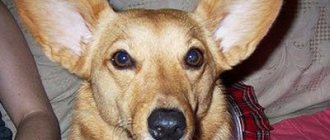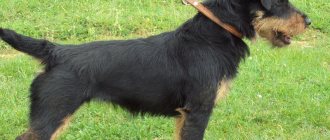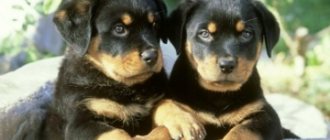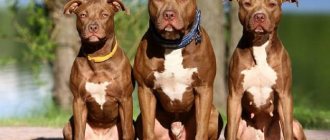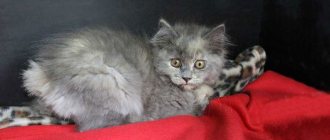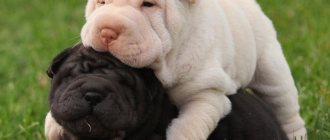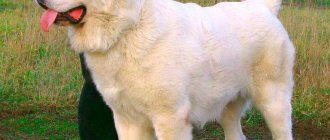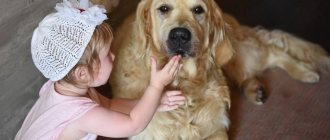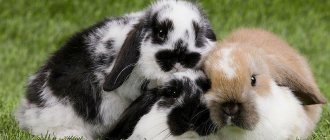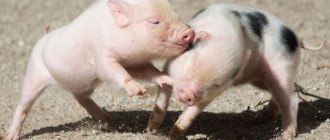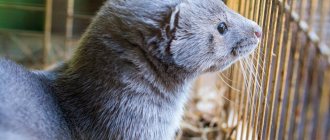The dachshund is an ancient hunting breed of dog.
It has only its own appearance with short legs and an elongated body.
Like real hunters, dachshunds are brave and resilient.
They know how to think logically, have intelligence and cunning.
As companions, dogs are cheerful and very sociable.
Photos of what newborn puppies look like
Puppies are born blind and deaf . React to pain, cold and touch. In the first week of life they only sleep and suckle. Healthy dachshund puppies feel dry and warm to the touch.
Babies cannot yet regulate their body temperature, so their place needs to be warmed up.
At three weeks of age, puppies are already active enough to explore their home..
How old do dachshund puppies grow?
Before a baby dachshund becomes an adult, it goes through several stages in its development:
- intrauterine – from fertilization to birth;
- neonatal or newborn – the first two weeks after birth;
- suckling – before the transition from breast milk to adult feeding;
- childhood - from one and a half to three months;
- adolescence - from four months to six months;
- youth – from 6 months to 1.5 years;
- adult dog - from one and a half years.
Puberty occurs from eight months to a year, but breeding dachshunds at this time is not recommended, since they have not yet fully formed, either physically or psychologically. Their growth stops, but the physiological development of the dachshund puppy and the gain of muscle mass continue. They are considered adults starting from 15-18 months.
When they open their eyes
Puppies open their eyes at 10-13 days . One eye may open before the other. After a week, the cub's gaze will be able to focus. At first, dogs only distinguish between light and dark.
Objects are seen dimly. During this period, puppies should be protected from bright light.
Good vision appears in the fourth or fifth week.
Prohibited Products
A dachshund prone to obesity and allergies should not be fed the following prohibited foods:
- Any sweets: chocolate, candies, cakes. These products cause allergies and poisoning in very young pets.
- Tubular bones of poultry and rabbit, any boiled bones. Splinters of tubular bones can perforate a dog’s intestines and cause death of the animal. Boiled bones lead to constipation and enterocolitis.
- Sausages because they contain nitrate, a substance that causes degenerative changes in the liver.
- Onions and garlic, which can cause stomach ulcers.
- Salty, sweet, spicy, pickled foods that the dog’s liver cannot handle.
- Pork, kebab, fried and fatty foods, leading to cirrhosis of the liver.
- Potatoes, which can cause obesity and diabetes.
- Human food, spoiled food.
- Grapes, citrus fruits, mushrooms.
Dimensions and weight
Puppies are born quite large. Their weight in relation to the mother's weight is 7-8%. Dachshunds are growing very rapidly.
After a week they weigh twice as much as at birth, after two weeks - three times as much.
By the age of one month, the weight of puppies increases 7-8 times. One and a half month old babies weigh ten times more than newborns.
How much is the dachshund
If you decide to buy a Dachshund puppy for your own pleasure and do not plan to participate in exhibitions, trials or hunting, then purchasing online or even at the market may be suitable for you.
The price in this case will not be too high - only a few thousand rubles. As a rule, such dachshunds do not have documents, and you consciously assume all future risks regarding the health of your pet and the compliance of its appearance with the requirements of the standard. It is possible that today’s cute puppy, when he grows up, will turn out to be either not at all or not at all like a dachshund, either in character or in appearance. The price for a “legalized” puppy, which has all the necessary documents, has undergone age-appropriate vaccinations and meets the standard requirements, will start at 20 thousand rubles. You shouldn't be surprised by such a serious figure. Even this price in most cases rarely covers the costs of a responsible breeder associated with breeding, providing proper care for the puppy and the babies born, and completing all the necessary documents.
How it develops day by day in the first month
| Age | Stages of development |
| 1-10 day | Puppies are blind and deaf, but have a developed sense of smell and touch and respond to touch. They sleep and suckle their mother. |
| 4 day | Already knows how to find the mother’s milkiest nipples, knows her smell |
| 5 day | The nose is stained |
| Day 8 | The puppy weighs twice as much as at birth |
| 10-14 day | Eyes open, can crawl, growl at other puppies, can suck from a bottle |
| 14-21 | The puppy begins to hear, walk, play, and may begin to eat solid food. |
| 21-30 | The first teeth appear. The kids are actively exploring the territory. For the first time they begin to wag their tail. The mother can leave the cubs for a long time. |
Marriage or separate breed
Dachshunds are originally the result of a disease or mutation. Dachshund is a dwarf breed. But the mutation turned out to be useful and was fixed. Reduction in size is also the result of targeted selection. Thanks to the efforts of specialists, the breed standard recognizes three varieties of dachshunds, differing in size.
The Miniature Dachshund is one of the breed varieties. Can take part in exhibitions, competitions, win titles. The character and skills of all varieties of dachshunds are almost identical.
How it develops from 1 to 12 months
| Puppy age | Stages of development |
| 1 month | The two main activities are eating and sleeping. Puppies grow quickly, gain weight, and recognize bright objects. From two weeks of age they can move independently |
| 2 month | Teeth appear, it is possible and even beneficial to give something solid as food, something that can be chewed, for example, a carrot. The active development of living space begins. Puppies need supervision. |
| 3 month | Character is formed. The first walks begin. The puppy tries to walk on a leash, gets the basics of training |
| 4 month | Awareness of one’s “social” role, one’s place in the “pack.” The first attempts to demonstrate a leadership character. |
| 4-8 month | The puppy may run away from its owner |
| 5-6 month | Walking increases |
| 6-10 month | Puberty begins. The bitch is in her first heat, and the males are marking their territory. |
| 8-9 month | All permanent teeth grow, relationships of subordination and leadership are consolidated |
Breed standards
Today, the rabbit dachshund is in demand for its genuine optimism. It is rare, but there are puppies of non-standard color in case of mixing of blood lines. Dachshunds mature quickly and are already considered fully formed adults at 6 months. Often they begin to suffer quite early from diseases of the spinal column or paralysis of the hind legs.
The weight of a miniature dachshund puppy is 4-5 kg, a standard one - 9-13 kg. A baby's weight at 2 months is 2-3 kg in life. Dachshund (3 months) - 3 kg. Chest circumference is:
- standard dachshund - 3-5 cm;
- miniature - up to 3-7 cm;
- rabbit - up to 25 cm.
How to care?
Caring for a puppy involves taking care of its health.
This includes proper feeding, timely deworming, and timely vaccinations. Walks are a must, especially with such an active dog as a dachshund .
Raising a dog should be handled by one person, it is advisable to immediately make it clear who is boss in the house. Rules of behavior are taught as early as possible and strictly adhered to, without making any concessions. Violence cannot be used as punishment.
You can express your dissatisfaction with the dog’s behavior by temporarily not paying attention to it, dachshunds are smart, they will understand everything:
- The puppy should have its own toys, clean warm bedding, and a place to feed.
- The pet's nails are trimmed as needed.
- Wipe the eyes with a warm, damp cloth.
- It is better to clean your ears by instilling a special lotion. It will contribute to the accumulation of dirt on the inside of the ear, from where it can be easily removed with a napkin.
- There are special brushes and toothpastes for teeth.
- The wool is wiped with a terry towel or a soft brush.
- Wash puppies if necessary and only with water without chemicals.
Description of the breed
The dachshund is valued not for its long legs, like a number of hound dogs, but for its speed, agility, lightness, and quick access to holes. A German breeder developed a unique breed adapted specifically for burrow hunting.
During the time of Bonaparte, many leaders of Tsarist Russia bred this particular breed. Depending on the size, weight, degree of endurance and adaptability to hunting, the dachshund has many varieties. What do dachshund puppies look like?
A typical dog of this breed has:
- cone-shaped elongated muzzle;
- strong jaws;
- correct bite;
- rather short legs;
- height from 13 to 27 cm;
- elongation of the tail;
- elongation of the body;
- muscular body;
- squinting eyes;
- balance of behavior;
- speed of reaction;
- courage;
- a tracker's keen sense of smell;
- squatness.
By nature, the dachshund is smart, sociable and inquisitive, and is classified as sanguine.
The dachshund is easy to train and is obedient. Most adapted for burrow hunting and tracking prey.
First walks
The first walks usually begin after the end of quarantine after vaccination (two weeks after vaccination).
For walks to go well, the puppy must:
- know your master well;
- respond to your nickname;
- be able to walk on a leash;
- know the basic commands “fu” and “come”.
In the first days, it is advisable to walk along one route so that the puppy gets comfortable.
CAREFULLY!
It is better to avoid contact with adult dogs; they may not calculate their strength and injure the puppy even during play.
At first, young pets are walked frequently, but not for long, so that the puppies do not get tired emotionally and physically.
Factors influencing growth
The development of dogs is influenced by a complex of factors:
- Genetic predisposition, quality of pedigree.
- Keeping a mother dog during pregnancy.
- Quality of mother's milk, duration of feeding.
- Phys. activity. A developing body needs to spend at least 3 hours a day outside. The first walk is a week after the 2nd vaccination. First, the puppy is carried out in warm weather, and over time is taught to walk on a leash or harness.
- Environment. Constant stress, noise, screams, and an alarming environment are extremely negative factors for a puppy. Their consequences range from aggressive behavior to developmental inhibition.
What to feed for the first three months
For the first week and a half, puppies only suckle their mother . The role of the person at this time is to ensure that all the cubs receive enough milk so that the stronger ones do not push the weaker ones aside.
Weak babies should be transferred to the rear, milkiest nipples of the bitch. They take the babies carefully, picking them up from below with their palms under their sides, or under their chest and butt. Well-fed puppies sleep, and hungry ones crawl restlessly.
From 10-12 days of age, puppies can be fed (if necessary) . Prepare a mixture of boiled cow's or goat's milk, diluted 1/3 with water or a weak infusion of tea, and a raw chicken egg (one egg per 0.5 liter of milk). The temperature of the mixture should be 28-30°C.
The cubs are bottle fed. When the puppies' eyes open, they are taught to lap the mixture from a saucer. With a small litter and a sufficient amount of milk from the mother, complementary feeding begins on the 20th day.
They feed the babies 4-5 times a day in small portions, making sure that the puppy’s bellies do not swell too much . Overeating is one of the main dangers to a dachshund's health; an overloaded stomach can lead to sagging of the back and curvature of the shoulder blades.
3-5 days after the start of complementary feeding, milk and curd mixture, oatmeal and rice porridge, mashed boiled vegetables and meat are introduced into the puppies’ diet.
Long-term feeding with mother's milk strengthens the puppies' body and increases resistance to diseases.
From two months of age, raw cartilage is occasionally given, and from 4-5 months, soft beef bones can be given.
For proper development, your dog needs vitamins and mineral supplements. To avoid rickets, you need phosphorus and calcium. The norms and form of mineral supplements are determined by a veterinarian.
Once a day, add a teaspoon of fish oil and crushed eggshells to your food..
Your pet should always have clean water in his bowl.
Mating
A special characteristic of the breed is its long, non-standard body. Because of this specificity, animals need conditions. Therefore, for mating, it is recommended to invite a specialist who knows the positions in which the dogs will be comfortable.
If the pet is a breeder, then mating is carried out through a nursery or club, where a mate is selected for it. The owner fills out the form and receives a certificate. Later, the owners agree on the time and place of mating. The price is set by the owner of the dog. Usually, it is equal to one puppy or a percentage of its cost (2-3 puppies in a litter - 50%, 4 - 75%, etc.) . If the female is empty, mating is not paid for.
Dachshunds mature early. By 8-10 months, girls begin their first heat. But they are allowed to untie only by the age of 2. Days 13-15 of the third cycle are considered favorable; they can be determined by several criteria:
- The loop turns from solid to loose;
- The discharge becomes lighter in color and may contain blood;
- The female becomes playful and invites the male with her tail.
Animals are dewormed within 2 weeks and checked for possible pathologies in a veterinary clinic. Pets must complement each other, that is, the shortcomings of one are compensated by the advantages of the other.
On the appointed day, the female is brought to the boy’s territory, where he will feel relaxed. The pets are walked together and given time to get to know each other. If the female is satisfied with everything, then she will allow the male to cage. Otherwise, you can try the next day or choose another male.
Sexual intercourse lasts from 10 to 20 minutes. At this time, Dachshunds are helped. The girl is held by the head and under the stomach, the boy is sent into a noose. For better balance, you can cover the dogs with pillows. Even if there was no castle, the female may be plump. Mating is repeated after 2 days. Pregnancy can be checked at veterinary ultrasound centers.
How to feed correctly and how often
Puppies are fed six times a day in small portions. Everything in the bowl must be completely eaten and the bowl must be licked clean. If this does not happen, the portion is reduced.
After eating, the puppy should want to play, and not lie exhausted from the amount of food he has eaten.:
- At three months, feeding frequency is 3-4 times a day
- At six months - 2-3 times a day
- After a year - 2 times a day
Sample menu for a dachshund puppy:
- breakfast - a mixture of milk and cottage cheese;
- second breakfast (four hours later) - meat broth with vegetables;
- lunch - porridge (oatmeal, buckwheat, rice) with milk or meat broth;
- dinner - small pieces of meat with vegetables, or with porridge;
- at night - fermented milk products.
The only sure way to know whether a dog is developing correctly is to weigh it regularly. The first two weeks this is done once every two days, then once a week.
There is nothing to worry about if the puppy:
- regularly gains weight;
- sleeps after eating;
- has a healthy appetite.
Advantages and disadvantages of dachshunds
Dachshunds are popular in many countries. Most of their owners are in favor of this breed and will not agree to exchange it for another. Energy, artistry, courage - this is not a complete list of the advantages of these dogs. Dachshunds can be a good assistant for a hunter. Their short legs and flexible skin allow it to crawl into a narrow hole and reach the rodent. Dogs swim well and can bring back shot birds.
Intelligence, quick wit, resourcefulness, and devotion make this dog an excellent friend for a single person or a family with children. Despite their excellent character, dachshunds are touchy, jealous, do not like to be left alone, and require constant attention.
Due to its long body, the Dachshund often has problems with the spine, especially if it is not fed correctly and has become fat. Short legs do not allow the dog to jump like other breeds, and jumping from heights is also contraindicated for them (dogs can easily get injured).
The dachshund is a dog with a complex character. Some owners note that trying to train her is the same as raising a teenager. Sometimes she shows character and goes against the rules. Patience and understanding of the characteristics of a dachshund are the key to a good relationship with a dog.
Vaccination schedule and which ones should be done
The first vaccination is usually given by the breeder with a mandatory note in the puppy’s veterinary passport. Before vaccinations, puppies should not walk outside or interact with other animals.
A prerequisite for the first vaccination is two stages of its completion.:
- 2 months - first vaccination against plague, enteritis, hepatitis, adenovirus.
- 2.5 months - revaccination with the previous vaccine.
- 6-7 months - re-vaccination against leptospirosis.
- One year - third vaccination and plus against rabies.
- Then the dog is vaccinated again annually.
Before vaccinations, deworming must be carried out . The first such procedure is performed by the breeder when the puppies are three weeks old. The second deworming is done when the puppies are 1.5 months old, two weeks before the planned vaccination.
In order to prevent a possible allergic reaction to a medication in time, it is better to do the vaccination under the supervision of a veterinarian.
IMPORTANT!
Vaccination is given only to healthy animals.
If the puppy gets sick, the vaccination is postponed to another time.
History of the origin of the species
Some dog handlers are confident that the breed is aboriginal. Images of cute short-legged and long-bodied dogs are found on the tombs of ancient Egyptians. The assumption that the Dachshund was bred there can be scientifically proven.
The breed acquired its modern appearance in Germany (16th century), this country is considered its homeland. The animal is classified as a mutated hound due to the disease chondrodystrophy (a pathology in which the whole body grows, but the legs remain short). One way or another, the ancestors of the breed have not yet been found. It is believed that these are Bracchi hounds.
The name is translated from German as “badger” . In Russia, until the 19th century, dogs were called badgers, and later the German “Dax” into “Dachshund” .
Until 1870, when the standard was recognized, dogs were modified and new subspecies were created. That's when smaller Dachshunds and long-haired ones appeared.
How to bathe properly?
Puppies that are on their mother's milk should not be bathed . The bitch cleans them herself. Particularly dirty areas of babies can be wiped with a damp, then dry cloth.
It is imperative to take care of the cleanliness of the bedding in the puppy's nest. At first, the mother dachshund takes care of it herself. She licks the cubs and eats their feces.
Until the age of five months, puppies are not washed to avoid skin irritation . In case of emergency, wash only with water and overnight.
Character
All dogs of this breed are characterized not only by the ability to seek contact and mutual understanding with the owner - for it this is a necessity. Therefore, it is extremely important on your part to provide not only adequate care for the puppy, but also to find a common language with him. Otherwise, the puppies become vindictive, unfriendly and spiteful.
For all their devotion, representatives of this breed often commit various unpredictable actions. They tend to dig holes and behave so actively that the eyes of those present begin to ripple. Curiosity and curiosity are all that can be said about the main character traits of this breed. A puppy dachshund needs an eye and an eye - otherwise, it can create absolute bedlam in the apartment in a matter of minutes. That is why proper education and training is so important for them.
Dachshunds are curious and inquisitive
The Dachshund puppy is endowed with a sharp mind, he is independent and quick-witted - at the same time he has incredible charm. With attention on your part, very soon the dog will become the favorite of the whole family, but it is important not to spoil it.
If you don’t like communication too much, then don’t get yourself a breed like a dachshund—care involves constant contact with it. Your puppy's lively character and temperament require implementation - remember this.
A few words should be said about small children - dachshunds literally adore them, becoming devoted friends. All kinds of games of hide and seek and chase, hugs and races - your child gives a dog of this breed everything he needs in terms of emotions, communication and active recreation.
Baby teeth and cleaning
Baby teeth appear at three weeks of age. They are sharper than permanent and very fragile. Baby teeth grow completely by 5-6 weeks.
It is not always possible to judge by the bite of baby teeth what a dog's bite will be like . You need to carefully monitor the change of your puppy's teeth, since baby teeth that do not fall out in time can cause the formation of a malocclusion.
To prevent this from happening, you need to give the puppy something hard to chew on, like a carrot. Sometimes a loose baby tooth cannot fall out (especially baby canines) and interferes with the proper growth of permanent teeth.
In this case, they have to be removed. Playing with a puppy with a strong, but not dense rag can help in this matter; this will be the most painless way to remove a “stagnant” tooth .
Permanent teeth begin to replace baby teeth at 12-16 weeks. The process of changing teeth can be very painful for puppies.
The dog is taught to brush its teeth from the age of two months. First, use your own finger, wrapped in several layers of bandage. Apply paste to the bandage and wipe the outside of the teeth.
In the future, you can try using a baby brush . The procedure takes no more than 10 minutes. If the puppy endures the test, he should be rewarded.
Care and care
From birth to adulthood, puppies need to be monitored and monitored for their health. The first weeks of a dachshund's life are dangerous due to the appearance of infections. A common cause of death in puppies at this age is E. coli. A sick puppy screams incessantly, continuously crawls on the bedding, and passes loose stool. In this case, he needs immediate veterinary attention.
Expert opinion
Anna Abramenko
An avid dog lover. Experience in veterinary medicine since 2009.
Ask a Question
When a puppy is infected with E. coli, it is often fatal. It is necessary to separate the dog from the rest of the litter and provide him with qualified assistance.
Growing dachshunds' nails grow quickly. While feeding, the puppies rest their paws on the bitch's stomach, press around the nipple, and injure the skin. This causes pain to the dog, which may cause him to avoid feeding the next time. Therefore, puppies need to have their nails trimmed every week until they are one month old. Then this procedure is repeated every 10 days while the mother feeds the dogs. You only need to shorten the tips of the claws without touching the soft tissues.
This is interesting: What to name a dachshund puppy
A two-week-old dachshund puppy's eyes open. A gap appears on the side of the bridge of the nose and gradually increases until it opens completely. At this stage, puppies begin to distinguish objects. Vision becomes normal at 5 weeks. The owner of the dachshund should examine the dog and wash its eyes if an infection begins.
Interesting article: Dachshund price: how much does a Dachshund puppy cost in Russia
Along with vision, dachshunds develop hearing. Wax builds up in your dog's ear canals, causing a blockage. You need to clean them, pull out the hairs there from long-haired dachshunds.
Expert opinion
Anna Abramenko
An avid dog lover. Experience in veterinary medicine since 2009.
Ask a Question
Regardless of breed, puppies must be dewormed. The first time it is done at the age of 5-6 weeks, repeated with an interval of 10 days. Before using antihelminthic drugs, you need to read the instructions to calculate the correct dosage. Taking medication incorrectly can lead to the death of your dog.
How to train and what commands to teach
When starting to train a dachshund, you need to remember that this is a hunting dog and its hunting instincts are an unconditioned reflex..
The desire to track and pursue an animal, “plowing” the area in search of scented prey - all these are natural, ineradicable characteristics of the dachshund.
During training, unconditional irritating factors should not be allowed. The dachshund will not obey if it smells game or finds a mink.
Some training rules:
- the command must be spoken once;
- the command should always sound the same. It is necessary to decide how to say “fu” or “no”, “bring” or “fetch”;
- You need to praise your dog for success.
First basic commands:
- "to me" . You can start learning at home, at home. When the puppy comes running when called, you need to praise him and give him a treat. If the pet does not respond to a command spoken twice, you must bring it to the place from which it was called and repeat the command. If the training takes place outside, there is no need to run after the puppy, because it will look like a fun game. You need to turn around and pretend to leave. But you can’t let one puppy go far;
- "it is forbidden" . It is necessary to immediately prohibit doing unacceptable things, for example, chewing shoes. To satisfy natural needs, it is better to offer special toys for dogs;
- "sit" . When learning this command, you can lightly press on the dog's croup while holding the treat above his head. You can give the reward only when the puppy sits down.
Training and temperament
Dachshunds have a complex, sometimes capricious character. It is not so easy to teach this dog to follow the rules, but this is not due to his lack of intelligence. On the contrary, the dachshund has an innate sense of self-esteem, intelligence, pride, and independence that do not allow them to obey.
The future owner of a dachshund should expect that his pet can be spontaneous and unpredictable. A dog can be taught to follow commands, but sometimes it prefers to live by its own rules.
They begin to raise a dachshund from the moment they are weaned from their mother. Dog breeders note that the best age for a dog to do this is 2 months.
You need great patience and respect for the dog for it to become a good friend and protector. A sequence of actions, a reward system, and calm handling are a necessity when training puppies. When teaching the rules of behavior, life in a family, an apartment, you should not hit or shout at your pet. This can result in reverse aggression and resentment of the dog. The dachshund senses the owner’s mood well; simple reprimand has a positive result. The main thing is to make it clear that there is one master in the house, and she must follow his rules and carry out orders.
The hunting instinct pushes dachshunds to dig the ground. Dogs can turn a garden plot into a training ground after hostilities. It is advisable to be careful when there is a folded blanket on the sofa, and before sitting down, check if there is a pet under it.
Small puppies are gradually accustomed to the toilet and sleeping place. There must be a specially designated area for this. If the dog's owner wants her to follow his rules, for example, not to jump on the sofa or bed, then other family members do not need to allow her to do this either.
Expert opinion
Anna Abramenko
An avid dog lover. Experience in veterinary medicine since 2009.
Ask a Question
Dachshunds have inexhaustible energy and excitement. They were bred to search for prey and endowed with all the qualities of a hunting dog. On the street they chase birds or small animals. Despite its small stature, this animal will not be more afraid of the dog than itself and will fight back.
The energy of a dachshund is not for everyone. It will appeal to people who prefer an active lifestyle. The breed may look like a caricature due to its short legs, long body, and ears. But the animal becomes a good friend and protector for the owners. Read about other dogs with short legs in this article.
?
How to toilet train
To toilet train a puppy, you can’t do without a special absorbent diaper..
If the baby ignores the diaper and chooses another place for his needs that is more suitable from his point of view, you need to moisten a piece of cloth in its puddle and place it on the diaper, and wash the place chosen by the puppy with soap and vinegar to eliminate the smell.
The puppy will be guided by the smell, so it is better not to wash the diapers at first. Gradually accustoming your pet to a tray (a special “dog” one with low sides), you need to put his usual diaper in this tray.
If you place the tray in the hallway in front of the front door, then take it outside in front of the dog, you can gradually accustom him to using the toilet outside the house . It can be difficult to train a dachshund to relieve itself outside.
The puppy can endure it until he returns to his usual place home. In this case, a used puppy diaper will help, which you will have to take with you at first. You can also increase the walking time, walk in those places where the pet was able to leave its “marks”.
Maintenance in the house and apartment
For a puppy, be sure to buy a tray, prepare a blanket or blanket, a piece of fur for a bed, and toys. The only problem that the owner of a dachshund puppy who wants to keep him in an apartment or house may encounter is the animal’s increased physical activity (walk more often) and the desire to dig (walk more often and arrange outdoor games on the street).
Preparing the site and necessary purchases
Buy:
- two bowls (for water and food);
- litter tray;
- soft bedding;
- sunbed;
- house for place;
- harness;
- collar;
- leash;
- reusable diapers;
- nail clippers or guillotines;
- shampoo;
- combs and brushes;
- towels;
- toys.
Litter box training and walking
The tray must be very large so that the pet feels free in it. As soon as the puppy has eaten, put him in the toilet, and if he has done his business there, prepare a treat and praise him. Dogs do not bury their excrement, so you must be able to clean up the litter box on time. For a male dog, buy a tray with a post.
When the puppy wants to urinate, he sits down. Have time to lay down a newspaper or diaper, which you then put in the tray. Tray training requires a lot of patience. But it is much easier to teach him to ask to go to the toilet outside. But this will happen after three or four months. Until this time, it is advisable not to take the dog outside often.
Training your dog to be home alone
For many dogs, being separated from their owner and being alone at home is a real stress. You need to gradually accustom your pet to the fact that he will not always be in the company of his loved one. When you get home, play with the puppy and then feint. For the puppy to see, put on your outerwear again and jingle your keys. The puppy will get used to it and will not react negatively.
Your pet will gradually get used to parting if you often go out and then return after a short time, increasing the time of parting each time.
Toys
To prevent the owner’s slippers from becoming the pet’s favorite toy, you need to purchase a latex or rubber toy for the puppy. Balls with squeakers and regular balls to teach the puppy to perform the “Fetch” command, a pumpkin of cabbage or corn and other improvised means for playing - everything will come into use. The main thing is that the puppy plays in the company of the owner, because he really loves attention and active games with other puppies or people.
When weaned from mother
The longer puppies are fed their mother's milk, the stronger and healthier dogs they will grow up to be..
In the fifth week, the puppies are gradually separated from their mother, first the strongest, then all of them in turn.
At this time, the puppies already have their first baby teeth, and they can try to eat solid food . The bitch's milk supply also decreases.
It is necessary to wean from the mother not in an instant, but by alternating mother’s milk and new liquid food. Then the transition will happen painlessly.
Choosing a place and utensils for feeding
Most often, small puppies eat so actively that liquid and dry food contaminants remain on the walls and floor of the feeding area. Considering the likelihood of constant cleaning, it is better to feed your cute baby in non-residential rooms - the kitchen or bathroom.
The place for feeding should be the only one and constant for the entire life of the small pet, so the issue of choosing a place and utensils for feeding must be taken care of even before acquiring a little friend.
Very young dachshund puppies can be fed from a small saucer. As the pet gets older, its muzzle will stretch out, so the grown-up baby will need to be fed from a deep bowl.
It is recommended to immediately purchase two bowls: one for food, the other for water. After each feeding and in the evening, you need to wash both bowls in running water.
- You should not buy ceramic bowls
- Plastic dishes for a dachshund should be made of high-quality durable material so that the dog cannot chew it while changing teeth.
- The optimal dishes for dachshunds are stable, deep bowls made of stainless steel. This material is strong, durable and hypoallergenic.
How to tell a boy from a girl
Gender is determined by physiological characteristics by examining the puppy’s tummy. Females will have only papillae and a navel on their belly, while males will have a barely visible genital organ.
Just don’t rush into determining the sex, since newborn babies’ genitals are still poorly defined; there’s no need to take the puppies away from their mother again, so as not to irritate either the mother or her cubs.
Males that have already reached the age of six months are distinguished by the habit of marking territory and raising their paws when urinating.
At 6-9 months, females may already have their first estrus.
Determining gender by appearance or behavior is problematic; all puppies at a young age are active and playful.
Safety regulations
The body type of the dachshund dictates particularly careful handling of the puppy.
You can’t drag him towards you by his front legs or pick him up unless absolutely necessary.
You should also not allow your dachshund to stand on its hind legs or jump off the sofa and armchairs: all this is fraught with deformation of the spine and the development of incorrect positioning of the limbs.
It is best to avoid going down stairs on your own for up to 9 months. Slippery floors in the house are another risk factor and should be covered with mats or rugs.
The Dachshund puppy is a family dog that loves companionship, walks and games.
How to choose?
The reputation of the nursery and breeder is important. You need to look at the puppies’ parents, their appearance, get acquainted with their merits and pedigrees.
Puppy selection criteria:
- thoroughbreds must have a mark on the belly or right ear;
- eyes - clear, brown, blue are allowed only for marble ones;
- bite - scissor bite;
- pink gums and tongue;
- ears are rounded, without folds;
- the back is flat without sagging or humps;
- the tail continues the line of the back, without creases;
- paws are not thin;
- the nose and claws are black, brown - in dachshunds the color is brown;
- The color of puppies is darker than that of adult dogs. With age, the color becomes less saturated. For black and tan dachshunds, the greater the contrast between the color of the tan and the base coat, the better. White markings are not allowed (except marble). The absence of tan in the black color is a sign of impure blood.
The puppy should be well-fed, but not fat, with clear skin without signs of disease.
NOTE!
You can check whether a cub is brave or timid, aggressive or calm, by making a little noise by rattling something in front of the puppy.
The puppy's reaction will tell you about its character.
The best option is if the baby did not snuggle, was not afraid, but showed interest and curiosity..
It is imperative to watch how the puppy moves, whether the movements are free.
Unacceptable elements of appearance and behavior:
- cowardice,
- aggressiveness,
- endless barking,
- tallness,
- high rear (croup higher than withers),
- excessive squatness,
- blue eyes (allowed only for merle-colored dachshunds),
- ears are too folded or pointed,
- sagging or hunchbacked back,
- frail chest,
- underdevelopment of muscles,
- clumsy movements, waddling,
- sparse coat with bald patches,
- the fur is too rough
- a tail without hair or, conversely, too long hair on the tail in the form of a brush,
- incomplete teeth, misaligned jaws.
The appearance of a puppy in the house is associated with endless worries, time, emotional and material costs . But all your efforts will pay off handsomely if you manage to raise a healthy, friendly, balanced dog.
Selection instructions
When choosing, you should pay attention to the appearance of the dachshund. She must have:
- wedge-shaped elongated head;
- pronounced brow ridges;
- White teeth;
- slanted brown eyes;
- thin floppy ears;
- short front legs;
- hind legs spread apart;
- shoulder strength;
- a rather long tail with its tapering towards the tip.
Hunting
When hunting, the dachshund transforms. She becomes a collected, passionate and merciless animal. There are cases when dachshunds rushed at large animals. Burrow hunting is very dangerous. A dog can not only die from the claws of a predator, but also be buried alive as a result of a collapse. For this reason, you should have a shovel in your hunting arsenal.
Having discovered a hole, the dachshund begins to bark at the victim and inflict stinging bites on it, forcing it to crawl to the surface. This breed is known for its death grip: the dachshund can keep its jaws closed for a long time.
At the same time, some dogs leave the victim in the hole because they lose interest in the defeated enemy.
Dachshunds hunt:
- hare;
- wild boar;
- badger;
- duck;
- fox;
- marten;
- ferret;
- ermine.
With proper training, a pack of dachshunds is capable of driving down deer and wolves.
Dachshund Personality: 7 Temperament Traits
The dachshund was created by hunting. Even the rabbit dachshund is not a decorative “ladies” variety of the breed. The smallest dachshunds were bred specifically to hunt rabbits. Only they could operate effectively in rabbit holes. With a standard dachshund they hunt not only burrowing animals (fox, badger), but also any other game. Character traits of these dogs:
Independent
There are several types of hunting dogs (gundog, hound, pointer and others). Most of them work in tandem with a person, expecting commands from the hunter. But not a dachshund. Burrowing dogs must find the animal themselves and hunt it down. The fight in a cramped dark hole takes place one on one, the man there is no help to the dog.
Dachshund at the fox hole
Therefore, the first quality of a dachshund is willfulness. From birth they try to live by their own mind, and not by orders. Because of this, the breed is classified as “difficult to train.” The dachshund learns commands easily, but every time he thinks about whether to carry them out.
Curious
The nose works around the clock in search of interesting smells. Once in a new room, the dog will not calm down until it examines every corner. All packages and your bag will be carefully scanned - what if there is something tasty in there? A walk for a dachshund is a real holiday, because there is a whole feast of smells outside.
Dachshund found a hedgehog in a summer cottage
Active, playful
Short crooked legs can deceive the ignorant. But dachshund owners know that these dogs have enormous endurance. If a dachshund is in good physical shape, it is ready to walk several kilometers every day.
Dachshunds definitely need to be given the opportunity to burn off their energy. They happily chase the ball, play with their relatives and amuse their owners with their antics. There is no need to assume that the dachshund runs slowly because of its short legs. If desired, it becomes a real torpedo!
I run faster than you think!
Affectionate
Like many hunting dogs, dachshunds can completely ignore their owner during a walk, rush around the dacha with ecstasy and find things to do on their own. But how loving they really are! Plopping on your back to scratch your belly, poking your nose under your arm and climbing to lick your nose is in the order of things.
Those who say “you can’t buy happiness” have not yet purchased a dachshund puppy.
If you win a dachshund's heart, you won't find a more affectionate dog. The same thing can be observed if you have a sandwich in your hands. Dachshunds love to be petted and cuddle with their owner in their sleep. Cozy and gentle, they snore so sweetly on the sofas - it’s easy to forget that this is a tireless hunter.
The bed is occupied!
Gambling
Most dachshunds do not know fear - they fiercely rush at an opponent much larger than themselves. And they often run into trouble. If the hunting passion awakens in a dachshund, it becomes deaf to your commands, feels neither pain nor fatigue, focusing on the goal. A dachshund is exactly the kind of dog that can bark for several hours at a cat that has saved itself in a tree. At the same time, biting into the trunk with his teeth and digging under the roots. Suddenly the tree does fall.
Wirehaired dachshund
Smart
Dachshunds do not participate in agility and cannot compare with service dog breeds in obedience, but not a single person will doubt their intelligence. It is the intelligence that gives the dachshund its special charm and cunning. They are damn inventive in their pranks, after which they beg for forgiveness so artistically that it becomes impossible to swear, only to giggle.
So why are you swearing, master?
Life-loving
Dachshunds are not sad, do not get offended, and do not worry about guilt. They do everything with such joy that you will fall in love with them. He eats with gusto, even if it is a carrot from the garden or a dry crust of bread. He hunts with passion. Dozing or basking in the sun with an expression of bliss on its face. For me, a dachshund is an endorphin dog!
Even if a pet's back legs fail, dachshund owners usually don't even think about euthanasia. Because their dog continues to enjoy life. Dachshunds' love of life helps them get out of any illness and charges everyone around with optimism.
